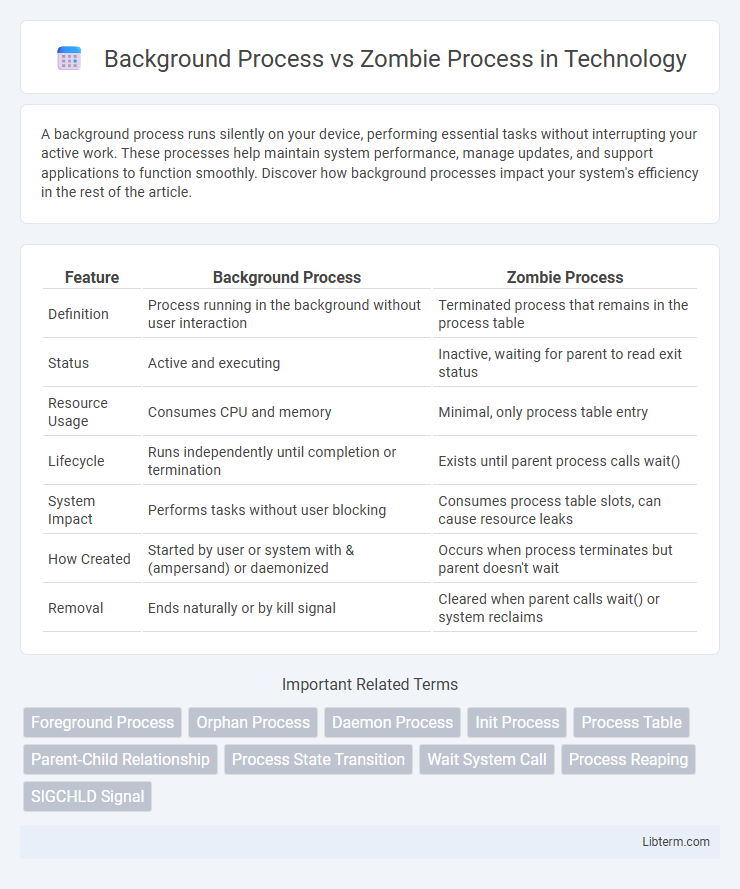A background process runs silently on your device, performing essential tasks without interrupting your active work. These processes help maintain system performance, manage updates, and support applications to function smoothly. Discover how background processes impact your system's efficiency in the rest of the article.
Table of Comparison
| Feature | Background Process | Zombie Process |
|---|---|---|
| Definition | Process running in the background without user interaction | Terminated process that remains in the process table |
| Status | Active and executing | Inactive, waiting for parent to read exit status |
| Resource Usage | Consumes CPU and memory | Minimal, only process table entry |
| Lifecycle | Runs independently until completion or termination | Exists until parent process calls wait() |
| System Impact | Performs tasks without user blocking | Consumes process table slots, can cause resource leaks |
| How Created | Started by user or system with & (ampersand) or daemonized | Occurs when process terminates but parent doesn't wait |
| Removal | Ends naturally or by kill signal | Cleared when parent calls wait() or system reclaims |
Introduction to Process Management in Operating Systems
Background processes run independently without user interaction, allowing operating systems to maintain multitasking and resource efficiency. Zombie processes are defunct processes that have completed execution but still occupy process table entries due to incomplete parent process cleanup. Effective process management in operating systems ensures proper handling of both background and zombie processes to optimize system stability and performance.
Defining Background Processes
Background processes run independently of user interfaces, allowing tasks to execute without user interaction. Common in operating systems like Unix and Linux, these processes enable multitasking by running scripts, services, or commands behind the scenes. Unlike zombie processes, background processes actively consume system resources and perform ongoing operations.
Understanding Zombie Processes
A zombie process is a terminated process that still occupies an entry in the process table because its parent has not yet read its exit status using the wait() system call. Unlike background processes that run independently without user interaction, zombie processes do not consume CPU resources but hold system memory, potentially leading to resource exhaustion if not cleared. Proper management involves ensuring parent processes correctly reap child processes to prevent accumulation of zombie entries in the system.
Key Differences Between Background and Zombie Processes
Background processes run independently without user intervention, actively performing tasks while the system remains responsive, whereas zombie processes are defunct processes that have completed execution but still occupy an entry in the process table. Background processes consume system resources as they execute, while zombie processes consume minimal resources but indicate improper cleanup of terminated child processes. The key difference lies in their state and system impact: background processes are active, and zombie processes are inactive remnants awaiting parent process acknowledgment to release system resources.
How Background Processes Work
Background processes run independently of user interaction by executing tasks asynchronously in the operating system, allowing other programs to continue running smoothly without waiting. These processes are initiated by commands appended with an ampersand (&) in Unix-like systems, which instructs the shell to run the process detached from the terminal. The operating system manages background processes by allocating system resources and prioritizing tasks while monitoring process states to optimize overall performance.
Lifecycle of a Zombie Process
A zombie process occurs after a child process has completed execution but still retains an entry in the process table because its parent has not yet read its exit status using the wait() system call. This lingering state ensures that the parent process can retrieve termination information, preventing the child process from becoming a resource leak. The lifecycle of a zombie process ends when the parent process calls wait(), allowing the operating system to remove the zombie's process descriptor from the process table.
Impacts on System Resources
Background processes operate actively with allocated CPU and memory resources, enabling multitasking without user intervention, while zombie processes consume minimal system resources but occupy process table entries, potentially leading to resource exhaustion if not cleared. The accumulation of zombie processes can degrade system performance by limiting the number of available process IDs and increasing kernel overhead. Efficient process management practices are essential to maintain system stability and optimize CPU and memory utilization.
Managing and Handling Background Processes
Managing background processes involves monitoring system resources and ensuring processes run efficiently without user intervention, often using job control commands like `bg`, `fg`, and `jobs` in Unix-based systems. Proper handling includes sending signals to pause, resume, or terminate these processes, preventing resource exhaustion and maintaining system stability. Implementing process supervision tools or scripts can automate background process management, reducing the risk of orphaned or zombie processes.
Cleaning Up Zombie Processes
Zombie processes occur when a child process has completed execution but still retains an entry in the process table to report its exit status to the parent. Cleaning up zombie processes involves the parent calling wait() or waitpid() system calls to read the child's exit status, allowing the system to release the process table entry. Ensuring proper signal handling with SIGCHLD and adopting techniques like double-forking helps prevent zombie accumulation by automatically reaping child processes.
Best Practices for Process Management
Background processes run independently without user interaction and are essential for multitasking, while zombie processes occur when a child process has finished execution but still holds an entry in the process table, causing resource leaks. Best practices for process management include ensuring proper parent process handling to reap zombie processes promptly using wait() system calls and implementing monitoring tools to track and manage background tasks effectively. Regular cleanup routines and limiting the number of concurrent processes help maintain system stability and optimize resource utilization.
Background Process Infographic

 libterm.com
libterm.com